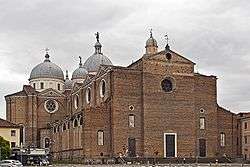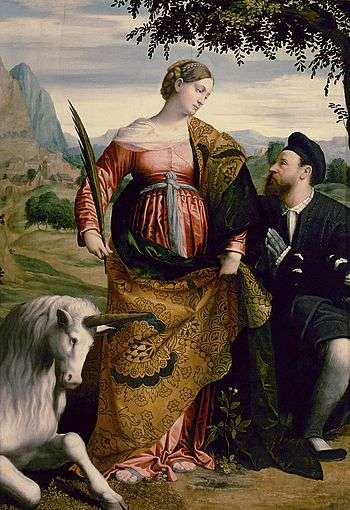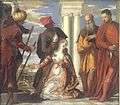Justina of Padua
Justina of Padua (Italian: Santa Giustina di Padova) is a Christian saint and a patroness of Padua. Her feast day is October 7. She is often confused with Justina of Antioch. She was devoted to religion from her earliest years and took the vow of perpetual virginity. When she was brought before Maximian the prefect, she remained firm against all attacks. The prefect caused her to be slain with the sword.
Saint Justina of Padua | |
|---|---|
Saint Justina by Bartolomeo Montagna | |
| Martyr | |
| Died | ~ 304 AD |
| Venerated in | Roman Catholic Church |
| Major shrine | Abbey of Santa Giustina |
| Feast | October 7 |
| Attributes | young woman setting a cross on the head of the devil while holding a lily in her hand; young woman with a crown, palm, and sword; young woman with a palm, book, and a sword in her breast; young woman with a unicorn, symbolizing virginity, and palm; young woman with Saint Prosdocimus |
| Patronage | Padua; Palmanova |
Hagiography
St. Justina of Padua (October 7) was a virgin of noble birth in the city which claims her patronage. Born at Padua about the middle of the first century, her father Vitalian was a rich nobleman and prefect of Padua. Her parents were converted to Christianity by the preaching of Saint Prosdocimo, and not having been blessed with children up to that time, they received Justina in answer to their prayer.[1]
She was devoted to religion from her earliest years and ultimately she took the vow of perpetual virginity. At this time arose the persecutions of the Christians by Nero, and Maximian the prefect who had succeeded Vitalian, proved himself particularly brutal. As Justina would visit the prisons to comfort and encourage the Christians there, Maximian ordered her arrest. While she was passing by the Pont Marin near Padua she was seized by the soldiers. When she was brought before Maximian he was struck by her beauty and endeavored by every means to shake her constancy. However she remained firm against all attacks and the prefect caused her to be slain with the sword.[1]
Medieval texts describe her as a disciple of Saint Peter the Apostle since Saint Prosdocimus, the first bishop of Padua, is said to have been Justina's teacher; his hagiography states that he was sent from Antioch by Peter. This however is chronologically impossible as Justina being a young woman in 304 AD could not have known Prosdocimus as he died in approximately 100 AD.
Veneration
St. Justina is a patron saint of Padua. After St. Mark, she is also a second patroness of Venice.[2] Her feast day is October 7 and coincided with the end of grape harvest and the time for settling agricultural contracts.[3]
In the 6th century the Paduans dedicated a church to her and she was among the virgin martyrs portrayed in the presbytery arch in the Euphrasian Basilica (at left) and in the procession of virgins in Sant'Apollinare Nuovo. In the 7th century, Venantius Fortunatus, writing in Gaul, urged travelers to Padua to visit her relics there.[4]
The Paduan Basilica and Abbey of Santa Giustina houses the Martyrdom of St. Justine by Paolo Veronese. The Abbey complex was founded in the 5th century on Justine's tomb, and in the 15th century became one of the most important monasteries in the area, until it was suppressed by Napoleon in 1810. In 1919 it was reopened. The tombs of several saints are housed in the interior, including those of Justina, Prosdocimus, St. Maximus, St. Urius, St. Felicitas, St. Julian, as well as relics of the Apostle St. Matthias and the Evangelist St. Luke.
Iconography
Justina is represented in Christian Art crowned as a princess, and with a sword transfixing her bosom, in accordance with her martyrdom, AD. 303.[5]
Gallery

 Justina of Padua by Mantegna
Justina of Padua by Mantegna Saint Justina with the Unicorn, circa 1530, by Moretto da Brescia
Saint Justina with the Unicorn, circa 1530, by Moretto da Brescia
See also
- Abbey of Santa Giustina
- Saint Justina of Padua, patron saint archive
References
- Allen Banks Hinds, M.A. “Saint Justina of Padua”. A Garner of Saints, 1900. CatholicSaints.Info. 20 April 2017

- Butler, Alban. "St. Justina of Padua, Virgin and Martyr", The Lives of the Saints. vol.X, 1866
- Knapton, Michael, Law, John E., Smith, Alison. Venice and the Veneto during the Renaissance, Firenze University Press, 2014 ISBN 9788866556633
- Stracke, Richard. "Saints Justina & Prodoscimus of Padua and Saints Justina & Cyprian of Antioch", ChristianIconography.info, University of Augusta
- Wagner, Leopold. "Patron Saints and Their Attributes", Manners, Customs, and Observances, London, William Heineman, 1894
| Wikimedia Commons has media related to Justina of Padua. |